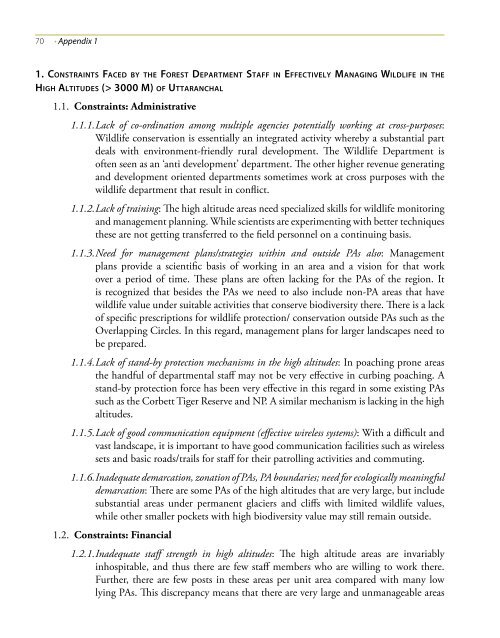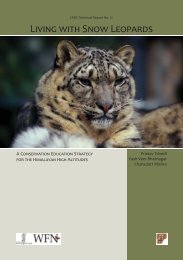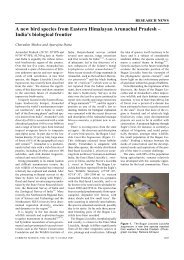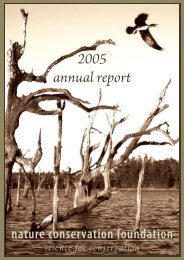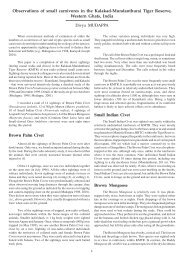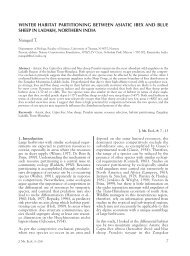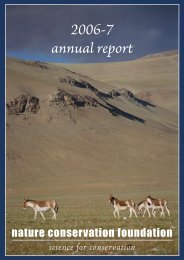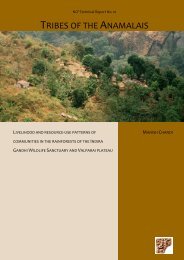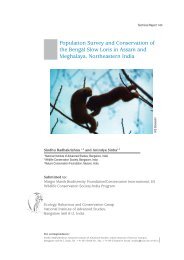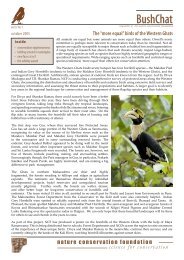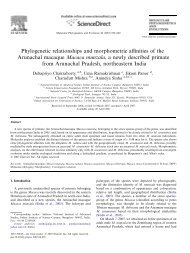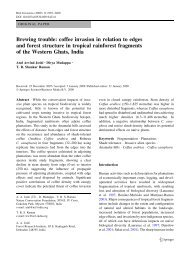towards project snow leopard - Nature Conservation Foundation
towards project snow leopard - Nature Conservation Foundation
towards project snow leopard - Nature Conservation Foundation
You also want an ePaper? Increase the reach of your titles
YUMPU automatically turns print PDFs into web optimized ePapers that Google loves.
70 • Appendix 1<br />
1. Constraints Faced by the Forest Department Staff in Effectively Managing Wildlife in the<br />
High Altitudes (> 3000 M) of Uttaranchal<br />
1.1. Constraints: Administrative<br />
1.1.1. Lack of co-ordination among multiple agencies potentially working at cross-purposes:<br />
Wildlife conservation is essentially an integrated activity whereby a substantial part<br />
deals with environment-friendly rural development. The Wildlife Department is<br />
often seen as an ‘anti development’ department. The other higher revenue generating<br />
and development oriented departments sometimes work at cross purposes with the<br />
wildlife department that result in conflict.<br />
1.1.2. Lack of training: The high altitude areas need specialized skills for wildlife monitoring<br />
and management planning. While scientists are experimenting with better techniques<br />
these are not getting transferred to the field personnel on a continuing basis.<br />
1.1.3. Need for management plans/strategies within and outside PAs also: Management<br />
plans provide a scientific basis of working in an area and a vision for that work<br />
over a period of time. These plans are often lacking for the PAs of the region. It<br />
is recognized that besides the PAs we need to also include non-PA areas that have<br />
wildlife value under suitable activities that conserve biodiversity there. There is a lack<br />
of specific prescriptions for wildlife protection/ conservation outside PAs such as the<br />
Overlapping Circles. In this regard, management plans for larger landscapes need to<br />
be prepared.<br />
1.1.4. Lack of stand-by protection mechanisms in the high altitudes: In poaching prone areas<br />
the handful of departmental staff may not be very effective in curbing poaching. A<br />
stand-by protection force has been very effective in this regard in some existing PAs<br />
such as the Corbett Tiger Reserve and NP. A similar mechanism is lacking in the high<br />
altitudes.<br />
1.1.5. Lack of good communication equipment (effective wireless systems): With a difficult and<br />
vast landscape, it is important to have good communication facilities such as wireless<br />
sets and basic roads/trails for staff for their patrolling activities and commuting.<br />
1.1.6. Inadequate demarcation, zonation of PAs, PA boundaries; need for ecologically meaningful<br />
demarcation: There are some PAs of the high altitudes that are very large, but include<br />
substantial areas under permanent glaciers and cliffs with limited wildlife values,<br />
while other smaller pockets with high biodiversity value may still remain outside.<br />
1.2. Constraints: Financial<br />
1.2.1. Inadequate staff strength in high altitudes: The high altitude areas are invariably<br />
inhospitable, and thus there are few staff members who are willing to work there.<br />
Further, there are few posts in these areas per unit area compared with many low<br />
lying PAs. This discrepancy means that there are very large and unmanageable areas


